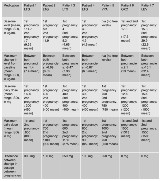Total Daily Dosage of Antiepileptic Drugs of Women With Epilepsy With Subsequent Pregnancies
Abstract number :
3.232
Submission category :
4. Clinical Epilepsy / 4E. Women
Year :
2018
Submission ID :
502700
Source :
www.aesnet.org
Presentation date :
12/3/2018 1:55:12 PM
Published date :
Nov 5, 2018, 18:00 PM
Authors :
Andrea Sanchez, Thomas Jefferson University; Scott Mintzer, Thomas Jefferson University; Lindsay Higdon, Thomas Jefferson University; and Maromi Nei, Thomas Jefferson University
Rationale: Antiepileptic drug (AED) levels often change during pregnancy in women with epilepsy (WWE). Dose adjustments during pregnancy are generally made only after AED levels change. However, fluctuations in AED levels as well as difficulties in obtaining timely levels may lead to breakthrough seizures and may possibly contribute to increased risk of other adverse consequences of epilepsy. Ideally, it would be useful to be able to predict necessary AED dose changes during pregnancy and implement changes in advance to prevent significant fluctuations and possibly obviate the need for frequent blood testing during pregnancy, particularly during a successive pregnancy in the same woman. It is unknown whether AED levels and dosing are similar between pregnancies in the same woman who remains on the same AED during successive pregnancies. We hypothesized that AED dose requirements between successive pregnancies in the same WWE on the same AED would follow a similar pattern throughout both pregnancies. Methods: A retrospective chart review of 12 WWE with > 1 pregnancy who attended the Jefferson Comprehensive Epilepsy Center between 01/01/1997 to 04/30/18 was conducted. All women who had at least 2 pregnancies on the same medication and had blood levels drawn during pregnancy were included in the study. A total of seven patients were included in final analysis. Results: There were four women with multiple completed pregnancies on lamotrigine (LTG), and one each on valproic acid (VPA), levetiracetam (LEV), and oxcarbazepine (OXC). Six were seizure free, while one woman with generalized epilepsy on LTG had a seizure four days after delivery. Of the seven WWE who were identified, the four WWE on LTG showed a mean increase of 710 mg in total daily dose during their respective pregnancies. For LTG patients, the difference in change in dose between pregnancies varied between 100 to 500 mg. The patient on VPA required a slight increase in dose toward the end of her first pregnancy only, from 750 mg to 1000 mg. The patient on LEV had no change in dose during either pregnancy. The OXC patient had a similar dose increase in both pregnancies. See Table for details. Conclusions: Our study suggests that total daily AED dosages used in women with subsequent pregnancies follow a similar pattern for most patients except for LTG patients, in whom dose changes between pregnancies were more variable, though all had dose increases. This variation may reflect differences in the timing of blood level testing, variability in practitioner dose change recommendations during different pregnancies, inter-pregnancy maternal physiology variability, and other factors. The doses used during an initial pregnancy may be somewhat useful in guiding AED dose management in successive pregnancies, but frequent testing of levels may still be needed, particularly in LTG patients. Larger studies are needed to evaluate and confirm these preliminary findings. Funding: No funding was received in support of this abstract.
